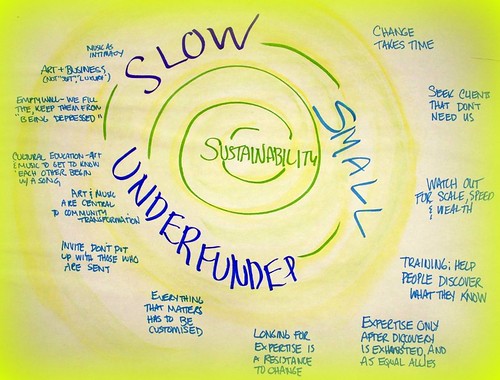 Dave Cormier pinged me the other day while I was away from my computer and pointed me to the reflections of a participant in the two week workshop he has just been facilitating on “Educational Technology and the Adult Learner.” (He also called it a “community curriculum.”) The post warmed the cockles of my heart. Thanks, Dave.
Dave Cormier pinged me the other day while I was away from my computer and pointed me to the reflections of a participant in the two week workshop he has just been facilitating on “Educational Technology and the Adult Learner.” (He also called it a “community curriculum.”) The post warmed the cockles of my heart. Thanks, Dave.
Leslie’s Last Day reflections | ED366H Educational Technology and the Adult Learner
I leave the class with new connections and community networks, there is that community word that keeps popping up. Along with the curriculum I left with alot of great advice and direction from fellow learners. I have a much better sense of virtual communities for social and professional networking. We so often hear that people don’t communicate any more, well looks like we communicate with many more and it is creating alot of great work. It is like the collective consciousness we hear about, technology is helping us to tap into it and to help manifest it exponentially.
Dave reflected that the two week experiment tossed people in deep and created an experience. He wrote about his overarching goal:
There were three main goals that I was hoping for from the course… all hoping to change the focus from ‘the material’ to the ‘experience’.
Sometimes I call these “transformative experiences” – often accompanied by some degree of discomfort and angst until the view gets sorted out a bit. But it also creates the community of learning, forged out of the challenge. Again, Dave wrote:
Community Literacies esp. Community commitment
Maybe the most important part of the of a course like this are the community literacies that are accumulated through a community enquiry into new material. The learners found that they could work together and rely on each other. They wrote nightly reflections and commented and helped each other with their work and reactions to the course. the sense of ‘competition’ between students evaporated. A sense of responsibility to the work at hand became stronger as the students found less and less direct guidance coming from the front of the room.They also got a sense of how I relate with my own online community and how that serves me in my own professional and, indeed, personal ways. Knowing that we have a community to rely on can be as much an emotional support to our practice as a technical one. Each student has remarked, in one sense or another, how their nightly blogging (closed, sadly) has allowed them to understand that they weren’t alone in their moments of frustration or overwhelmedness. Thinking of your professional life as something that can contain a community that can do all those things can be a very powerful realization.
Notice the reflective practice here, that pulls the learning out of the leap.
I find working with online interaction and the variety of tools and media at our disposal starts making more sense only after a deep dive. That tickling on the surface doesn’t reveal the possibilities as well as jumping in all the way, even if it makes us feel inadequate or lost.
This makes it harder to convince the reluctant. It reminds me of the Guillaume Apollinaire quote:
Come to the edge, he said.
They said: We are afraid.
Come to the edge, he said.
They came.
He pushed them…. and they flew.
Photo Credit:
![]() Uploaded on November 3, 2007
Uploaded on November 3, 2007
by laurenatclemson
 This post from the sparky, smart and witty Vicki Scholtz is the best chuckle of the day for me. This post is a response to participation in the recent
This post from the sparky, smart and witty Vicki Scholtz is the best chuckle of the day for me. This post is a response to participation in the recent  I’m back from over three weeks of travel in Europe and I realized that if I didn’t sit down and write at least one blog post, no matter how trite or incomplete, I will have gone nearly a month without a blog post and I’ve not done that since I started this blog (over on it’s original blogger home) in 2004. The fact that I missed my own blogaversary in May this year tells you that blogging has simply become part of the fabric of my work and life, and yet this gap… oi! I have tons of drafted posts and lots of things that I “planned” to blog about, but time has been tight.
I’m back from over three weeks of travel in Europe and I realized that if I didn’t sit down and write at least one blog post, no matter how trite or incomplete, I will have gone nearly a month without a blog post and I’ve not done that since I started this blog (over on it’s original blogger home) in 2004. The fact that I missed my own blogaversary in May this year tells you that blogging has simply become part of the fabric of my work and life, and yet this gap… oi! I have tons of drafted posts and lots of things that I “planned” to blog about, but time has been tight.